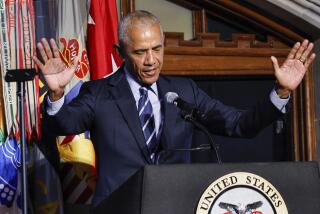Clinton Drafted in Final Push to Help Gore
- Share via
WASHINGTON — After almost three months on the sidelines, President Clinton is preparing to hit the campaign trail and use his considerable political skills to help the Democratic cause in the Nov. 7 election.
The blitz by Clinton will be aimed largely at propelling the Democratic faithful to the polls in key states. Boasting the highest job approval ratings since President Eisenhower’s second term, Clinton is heavy artillery for his party.
“Pack your bags,” presidential spokesman Jake Siewert told the White House press corps. “Get ready.”
Vice President Al Gore is eager for Clinton’s help in turning out the party’s core voters but mindful of the need to keep some distance from the president. In a delicate balance, he needs Clinton’s charisma but worries that presidential appearances will remind uncommitted and swing voters of the scandals of the Clinton presidency. Thus both men will spend plenty of time campaigning in the battleground states--but not together.
“You don’t have to be Albert Einstein to know there is some risk,” said Stuart Rothenberg, an independent political analyst.
Rothenberg added that the Democrats are only taking the risk because the election is so close. “If Gore were up 10 points, this wouldn’t happen. There would be a lot of golf to be played otherwise,” he said, referring to the president’s favorite pastime.
Rallying the party faithful “is important in any election,” said one Gore aide who asked not to be identified. He added that it’s “particularly important in a close election. It’s all hands on deck this year,” including Clinton, who is “obviously a great motivator for Democratic voters.”
Yet the Gore campaign, while implicitly recognizing the power of the president as a party leader, is careful in discussing the subject.
“Our approach is that it’s traditional for the nominee to be out there carrying the message and have other folks turning out the base and raising the money,” Gore campaign spokesman Douglas Hattaway said.
With large numbers of indifferent and uncommitted voters who may choose to stay home, the contests--at the presidential level as well as in Senate and House races--may depend on the ability of Democrats and Republicans to get their most fervent partisans to the polls.
The president can be particularly helpful in states such as Michigan and New Jersey, two key areas that have significant numbers of union members and African American voters--among the president’s most enthusiastic supporters. Florida and Pennsylvania also are likely destinations for Clinton, said one knowledgeable Democratic congressional staff aide.
In California, Gore has a significant lead in the polls but Clinton is expected to make at least one--and possibly more--campaign trips to help boost turnout for congressional candidates.
“California might be the exception to every rule,” Siewert said in an interview. “The president will spend time in California. He will be in California because it’s a state where he has a lot of friends and a lot of people he’d like to help. . . . There are a lot of close races and the president will be there between now and election day.”
Yet, while Clinton’s appearances can boost the hearts and hopes of the Democratic faithful, the effect might be negative for uncommitted and wavering voters.
“He can mobilize the base, but I’m not sure the base is the problem now,” Rothenberg said. “Weak Democrats are the problem. Weak partisans, swing voters and ticket-splitters are the problem. These are the voters that are important.”
Mark D. Fabiani, deputy Gore campaign manager, refused to speculate about the potential downside of Clinton’s participation in the final days of the campaign. “Our sole and complete focus in on Al Gore,” he said.
This year, Clinton largely has confined his political travels to the dinners, luncheons and other fund-raising events hosted by Democrats. At more than 140 events, he has collected almost $100 million--an unprecedented bonanza--for the party and its candidates.
Now, he will hit the hustings, talking to large numbers of general election voters rather than small groups of affluent donors. “The president is going to go out and talk to Democrats but [also] talk to the people of America” about the economy, crime and welfare reform, Siewert said.
Political analysts noted that, while the president continues to command the rapt allegiance of Democratic donors, his moral missteps and the impeachment that followed might have tainted him as a Gore spokesman before broader audiences.
Now, however, the back-and-forth race between Gore and Texas Gov. George W. Bush is breaking down reluctance to use the president as a campaigner before masses of voters.
With polls showing Gore and Bush running neck and neck, Democratic political strategists said Gore surely will lose if traditional Democratic constituencies--African Americans, Jews and union members--fail to vote in large numbers.
And that is where Clinton comes in.
“He’s loved by Democrats and by the base voters in the party--he can rev them up like few people can,” said Mark Mellman, a Democratic political analyst. “In all the key battleground states, the president can do a lot to excite and mobilize the base.”
Even before Thursday’s formal report of Clinton’s campaign plans, the president had begun the job of delivering the message to the strongest Democratic partisans.
Clinton has recorded radio advertisements and telephone messages used by phone banks contacting rank-and-file Democrats to urge people to vote for all the party’s nominees.
He also has conducted a series of meetings, urging ministers to emphasize to their largely African American congregations that they should go to the polls for Gore and for Democratic Senate and House candidates.
*
Times staff writer Edwin Chen contributed to this story.
More to Read
Get the L.A. Times Politics newsletter
Deeply reported insights into legislation, politics and policy from Sacramento, Washington and beyond. In your inbox twice per week.
You may occasionally receive promotional content from the Los Angeles Times.











